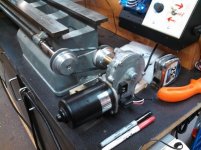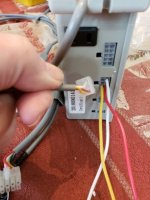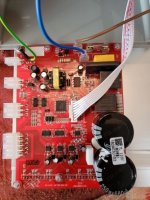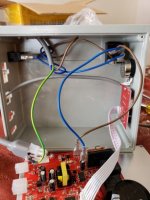Im building a small turning holder for finishing cues. I was going to go cheap and use a Sewing machine motor. Would anyone recommend a certain brand or model, or does it really matter? I wanted variable speed with the foot controller but maybe this is standard on all models? I dont do any sewing which is why I can use all the help I can get. lol Thanks, G
You are using an out of date browser. It may not display this or other websites correctly.
You should upgrade or use an alternative browser.
You should upgrade or use an alternative browser.
Which Sewing machine motor to get
- Thread starter Kingpin
- Start date
You don't need to spin your cues when finishing.
You just need to index them 4-5 spots depending your gun.
If you insist on spinning them, a cheap Harbor Freight $30 router and speed controller will do the job.
You just need to index them 4-5 spots depending your gun.
If you insist on spinning them, a cheap Harbor Freight $30 router and speed controller will do the job.
I bought the same one Whammo recommends about 5 yrs ago for my wife's consew machine so i can use if for leather. 
I bought this version to see what the difference is, for the set of centers i run in the planer for tapering shafts:
https://www.ebay.com/itm/Consew-CSM...481363&hash=item25d2acbea2:g:kpsAAOSwhQhY2rZN
My un-scientific impression across 2 very different applications is that the second motor is a little more stable under load. I will speculate further - despite the descriptions of both in some vendors hype as being "DC servo" motors, i suspect the first actually is. I "think" the second is probably a 3ph motor VFD combo; so it runs on single ph with better torque and stability. Again - never dug into it to verify. It flat works for my taper set up.
Per Joey's note, either one is overkill for a rotisserie for spraying, but they do stop and start almost instantly; and they are both already set up for a foot peddle as you desire. Enter "consew motor" as the search term in eBay and scan the price variations for both models. I think whichever is cheapest including shipping will serve fine for the application, and will be perfect for incremental stop/start.
It may be worth conveying - speed is preset by your choice of dial setting. Peddle is only on/off. (not an accelerator)
smt
I bought this version to see what the difference is, for the set of centers i run in the planer for tapering shafts:
https://www.ebay.com/itm/Consew-CSM...481363&hash=item25d2acbea2:g:kpsAAOSwhQhY2rZN
My un-scientific impression across 2 very different applications is that the second motor is a little more stable under load. I will speculate further - despite the descriptions of both in some vendors hype as being "DC servo" motors, i suspect the first actually is. I "think" the second is probably a 3ph motor VFD combo; so it runs on single ph with better torque and stability. Again - never dug into it to verify. It flat works for my taper set up.
Per Joey's note, either one is overkill for a rotisserie for spraying, but they do stop and start almost instantly; and they are both already set up for a foot peddle as you desire. Enter "consew motor" as the search term in eBay and scan the price variations for both models. I think whichever is cheapest including shipping will serve fine for the application, and will be perfect for incremental stop/start.
It may be worth conveying - speed is preset by your choice of dial setting. Peddle is only on/off. (not an accelerator)
smt
Last edited:
What RPMs are you looking for? Are you spraying, or applying with a brush/finger and need it to flow out while slow spinning?
If low RPMs are desired, I would recommend a windshield wiper motor coupled with a dc motor speed controller like this one...https://www.allelectronics.com/item/msc-35/3-amp-dc-motor-speed-controller/1.html
The wiper motors are strong, designed for prolonged use, and easy to find in a bone yard. A cheap speed controller is all thats needed to add.
Dave

If low RPMs are desired, I would recommend a windshield wiper motor coupled with a dc motor speed controller like this one...https://www.allelectronics.com/item/msc-35/3-amp-dc-motor-speed-controller/1.html
The wiper motors are strong, designed for prolonged use, and easy to find in a bone yard. A cheap speed controller is all thats needed to add.
Dave

If you buy the one Whammo posted, you won’t be able to use the foot control. I have the exact same motor and it works great but the foot pedal is set up to work with it mounted on the bottom (think sewing machine)and the pedal is attached to the lever which is spring loaded. You really need a smaller motor with a rheostat foot pedal. That motor is overkill for what you need.
I plan on putting together a finish/portable lathe to take to tournaments, do wraps, and finish work on. I’m going to get a 4’ bed with rack and pinion rail, large bore headstock, Taig carriage with rack & pinion, small sewing machine motor with rheostat control attached to the headstock, and a tailstock. I’d like to find some stuff used but I doubt I will.
Good luck!
I plan on putting together a finish/portable lathe to take to tournaments, do wraps, and finish work on. I’m going to get a 4’ bed with rack and pinion rail, large bore headstock, Taig carriage with rack & pinion, small sewing machine motor with rheostat control attached to the headstock, and a tailstock. I’d like to find some stuff used but I doubt I will.
Good luck!
JC
Coos Cues
You don't need to spin your cues when finishing.
You just need to index them 4-5 spots depending your gun.
If you insist on spinning them, a cheap Harbor Freight $30 router and speed controller will do the job.
Whether the cue requires spinning depends on what the finish is.
Whatever sewing machine motor you get make sure it has an infinite adjustable rheostat for speed control.
JC
I want both low and high speed. I'm not sure what kind of speeds an actual sewing machine motor is capable of. Just to get things going, I was planning to make some wooden blocks of different thickness to fit under the foot control and clamp it in position. That way I can spread epoxy at a higher speed, spray at low RPM and possibly sand and polish with an even higher speed. I know it sounds crude, and it is, but I only want to see how urethane clear works compared to 2 part epoxy.. I can get an entire sewing machine for 20.00 around here so I figured someone would know of a brand that would work for my tests. I will look into the other suggestions. Thank you
It sounds like the Mid-America workstation would do everything you need it do do. It’s only $375 and comes with everything you need to do what you’re wanting to do.
http://www.midamericapool.com/workstation.html
http://www.midamericapool.com/workstation.html
As a heads up...most normal sewing machine motors are NOT strong enough for what you describe.....been there done that and spent too much to find out. You would need 2 motors to accomplish what you want, or 2 different stations as you will be looking for high rpms, with torque, during sanding, then you need a low rpm with very little torque needed for slow spinning, which a foot pedal is not going to help, unless you want to stay there with your foot on it for 2 hours while it sets and cures. You need a controller as I linked earlier.
I haven't used the above mentioned motor, so I do not know the range of rpm it has, but I do a brush on finish and have a motor/controller setup that I run at about 1.5 rpm to allow even flow out, and I don't know of a motor that can do that and also run about 1000 rpm for sanding with the required torque also.
Dave
I haven't used the above mentioned motor, so I do not know the range of rpm it has, but I do a brush on finish and have a motor/controller setup that I run at about 1.5 rpm to allow even flow out, and I don't know of a motor that can do that and also run about 1000 rpm for sanding with the required torque also.
Dave
It sounds like the Mid-America workstation would do everything you need it do do. It’s only $375 and comes with everything you need to do what you’re wanting to do.
http://www.midamericapool.com/workstation.html
I have one of those..... but the little motor is absolute trash........... get a VS DC motor
Kim
Cheap low power old school home level sewing machines with an "accelerator" foot pedal do not have stable speed control vs load. Put your finger on the part and the motor will (easily/immediately) slow in direct proportion to pressure.
There's a big difference compared with aftermarket industrial machine replacement motors with SCR or VFD control. These will practically maintain set rpm even under load, until the load becomes great enough to stall them at that speed. They are not quite as powerful as the single speed high rpm clutch motors traditionally used in commercial sewing machines where you can feather the clutch a little, but the speed is always "full tilt boogie". But they allow homeowners with industrial machines to get the speed down where they are most comfortable and sew things like leather, plywood, etc.
The higher watt "Consew" (or similar) motors linked by some of us will go down to very few rpm with good torque, and up to either 3,600 or 4,500 rpm depending on model. If you are envisioning direct drive, then the slower version is necessary. If you figure on a pulley reduction or gearbox between motor and spindle, then any of them will work.
I like the wiper motor option. But it is not actually much cheaper after spending time in the junkyard to liberate one, find and match a controller, put together the other electric bits and set it up with a mount. If you are already a tinkerer, many of the parts will be free. If not they cost and require some self education. Some of my friends have used wiper motors for driving things like rotary tables for machining, etc, they do work well if you have facility to make any parts to adapt them. Wiper motors already have an integral gearbox and are probably even the best option for lower end of the rpm spectrum.
smt
There's a big difference compared with aftermarket industrial machine replacement motors with SCR or VFD control. These will practically maintain set rpm even under load, until the load becomes great enough to stall them at that speed. They are not quite as powerful as the single speed high rpm clutch motors traditionally used in commercial sewing machines where you can feather the clutch a little, but the speed is always "full tilt boogie". But they allow homeowners with industrial machines to get the speed down where they are most comfortable and sew things like leather, plywood, etc.
The higher watt "Consew" (or similar) motors linked by some of us will go down to very few rpm with good torque, and up to either 3,600 or 4,500 rpm depending on model. If you are envisioning direct drive, then the slower version is necessary. If you figure on a pulley reduction or gearbox between motor and spindle, then any of them will work.
I like the wiper motor option. But it is not actually much cheaper after spending time in the junkyard to liberate one, find and match a controller, put together the other electric bits and set it up with a mount. If you are already a tinkerer, many of the parts will be free. If not they cost and require some self education. Some of my friends have used wiper motors for driving things like rotary tables for machining, etc, they do work well if you have facility to make any parts to adapt them. Wiper motors already have an integral gearbox and are probably even the best option for lower end of the rpm spectrum.
smt
Attachments
Last edited:
That's good to know. My 3/4 hp servo motor goes from 0-5000 rpm. It is super quiet and has worked really well for me.
I’d be interested to see if I could control the speed any other way than the lever on my Consew. Here is a link to my setup that I put together.
https://i.imgur.com/bnc4wX9.jpg
https://i.imgur.com/bnc4wX9.jpg
Last edited:
is there a difference? I'm ordering today. One seems to have a better speed control. Correct? or am I missing something? Thanks
Most of the machines today have the "click" style rheostat. No matter what they tell you... I have had a dealer check each model number.. All the same... The older models had the smooth style.... You will want to replace it with one that is smooth turning for a nice controlled speed change...
I put the long skinny style with brushes on wife's consew so she could slow it down from original clutch motor. (Like lathe motor shown in photo) That was a few years ago, and the "lever" mentioned only controlled on/off. There is a dial on the box where yours shows a switch, that dials the speed. (There is no read-out to say what that speed is, though).
The short, larger dia motor on the centers on my planer in a previous photo have a similar set up & is "programmable" for things like forward/rev.
So the answer is "Yes, it is possible"; the question becomes "where to get the parts and how much do they cost". Or, keep an eye out for maybe some NOS that has the older systems. Not really much help but maybe a few clues.
smt
PS, considering the way many modern cue-makers work, this site needs an electronics guru for the more helpless among us, in which category i strongly list myself.
The short, larger dia motor on the centers on my planer in a previous photo have a similar set up & is "programmable" for things like forward/rev.
So the answer is "Yes, it is possible"; the question becomes "where to get the parts and how much do they cost". Or, keep an eye out for maybe some NOS that has the older systems. Not really much help but maybe a few clues.
smt
PS, considering the way many modern cue-makers work, this site needs an electronics guru for the more helpless among us, in which category i strongly list myself.
Last edited:
I wanted to follow up and show a project I have been working on. I bought each of the sewing machine motors that were discussed above, the "Enduro" motor https://smile.amazon.com/Enduro-Sewing-Machine-Motor-Electric/dp/B079P8RQRQ/ref=sr_1_2_sspa?ie=UTF8&qid=1543944064&sr=8-2-spons&keywords=sewing+machine+servo+motor&psc=1
and the Consew CSM-1000 (aka CS-1000) https://smile.amazon.com/Mophorn-CS1000-Machine-4500RPM-Industrial/dp/B07HFTMR8Z/ref=sr_1_14?ie=UTF8&qid=1543944064&sr=8-14&keywords=sewing+machine+servo+motor
that Ssonerai showed.
As Ssonerai suggested, the Enduro motor seems to be more of a simple DC motor whereas the CSM-1000 seems to be a true servo motor. When it is running, even at low speed, you would be hard pressed to stall it out by grabbing the pulley. When you do, the controller just gives it more juice, increasing the torque while maintaining the rpm.
The CS-1000 is much smaller and lighter weight, so I kept it and returned the Enduro - it was basically the same size and weight as the Penn State motor.
Both motors use a Hall Effects system to control the speed. I did some reading up on that technology and got to wondering if I couldn't replace the Hall Effects control with a simple potentiometer as a speed control. The short answer is Yes
There are a couple of connectors on the back of the motor control housing, the smaller 6-wire connector goes to the original speed control, even though only 3 wires are used. The Red and White wires are the +5v and common and the Yellow wire is the wiper. Using the original speed control, I found that when the motor stopped, there was 1.00 VDC (using a multimeter) between the White and the Yellow lead at the connector. As I increased the speed, the voltage increased to 4.21VDC at 4500 rpm.
So I hooked up 1kohm variable potentiometer as shown in the pictures below and VOILA, I was able to control the speed of the motor.
One thing to keep in mind if you try this yourself, is that without that 1 volt signal at zero rpms, the motor control will give you an ER-4 error, which basically means it thinks the foot pedal is not connected. So with the potentiometer connected, turn it down to where the motor stops running, but not all the way to the left. Then, when next you power up the motor control box, it will sense ~1 volt and allow you to increase the speed of the motor by turning the potentiometer to the right.
I also found the the speed readout on the motor control box is reasonably accurate.
One other quirk about the speed control is that it will only speed up the motor in 100 rpm increments, not in a smooth ramp up, so that may be a show stopper for some of you.
Finally, the CYA section - I am neither an Electrician nor and Electronics Engineer, so I cannot be responsible for any damage to you or your motor if you should try to do this. But I have tried to document what works for me.
The next phase of the project will be to try to document the missing P-XX values and what they do. I have asked the seller and they have promised, in turn, to ask manufacturer, but I'm skeptical that I will get any info back from them.
Hope this helps,
Gary
and the Consew CSM-1000 (aka CS-1000) https://smile.amazon.com/Mophorn-CS1000-Machine-4500RPM-Industrial/dp/B07HFTMR8Z/ref=sr_1_14?ie=UTF8&qid=1543944064&sr=8-14&keywords=sewing+machine+servo+motor
that Ssonerai showed.
As Ssonerai suggested, the Enduro motor seems to be more of a simple DC motor whereas the CSM-1000 seems to be a true servo motor. When it is running, even at low speed, you would be hard pressed to stall it out by grabbing the pulley. When you do, the controller just gives it more juice, increasing the torque while maintaining the rpm.
The CS-1000 is much smaller and lighter weight, so I kept it and returned the Enduro - it was basically the same size and weight as the Penn State motor.
Both motors use a Hall Effects system to control the speed. I did some reading up on that technology and got to wondering if I couldn't replace the Hall Effects control with a simple potentiometer as a speed control. The short answer is Yes
There are a couple of connectors on the back of the motor control housing, the smaller 6-wire connector goes to the original speed control, even though only 3 wires are used. The Red and White wires are the +5v and common and the Yellow wire is the wiper. Using the original speed control, I found that when the motor stopped, there was 1.00 VDC (using a multimeter) between the White and the Yellow lead at the connector. As I increased the speed, the voltage increased to 4.21VDC at 4500 rpm.
So I hooked up 1kohm variable potentiometer as shown in the pictures below and VOILA, I was able to control the speed of the motor.
One thing to keep in mind if you try this yourself, is that without that 1 volt signal at zero rpms, the motor control will give you an ER-4 error, which basically means it thinks the foot pedal is not connected. So with the potentiometer connected, turn it down to where the motor stops running, but not all the way to the left. Then, when next you power up the motor control box, it will sense ~1 volt and allow you to increase the speed of the motor by turning the potentiometer to the right.
I also found the the speed readout on the motor control box is reasonably accurate.
One other quirk about the speed control is that it will only speed up the motor in 100 rpm increments, not in a smooth ramp up, so that may be a show stopper for some of you.
Finally, the CYA section - I am neither an Electrician nor and Electronics Engineer, so I cannot be responsible for any damage to you or your motor if you should try to do this. But I have tried to document what works for me.
The next phase of the project will be to try to document the missing P-XX values and what they do. I have asked the seller and they have promised, in turn, to ask manufacturer, but I'm skeptical that I will get any info back from them.
Hope this helps,
Gary
Attachments
Last edited:





